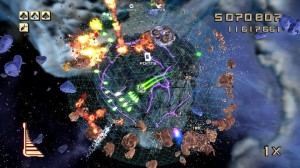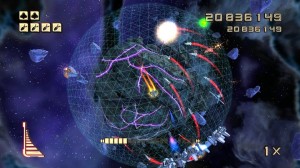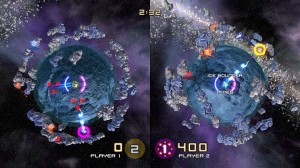Liverpool Sound and Vision Rating: * * * * *
Super Stardust Ultra is an arcade twin-stick shooting game available for download from the PlayStation Store for the PS4. The origins of Stardust date back to 1993 when a Finnish studio called Bloodhouse had their first game Stardust published for the Amiga 500, while another Finnish studio called Terramarque had their first game Elfmania published for the Amiga in 1994 with both Finnish studios Bloodhouse and Terramarque joining forces in 1995 to create Housemarque which produced their first game together in 1996 in the form of Super Stardust for the P.C.
Following that release; SCE contacted Housemarque which led to Super Stardust HD releasing for the PS3 via digital download on PSN in June 2007, with Housemarque also releasing Super Stardust Portable on PSP in 2008 and Super Stardust Delta on Vita in 2012. Despite Housemarque not being directly involved with development duties on Super Stardust Ultra due to further development for Resogun downloadable content on PS4 and upcoming projects including Alienation; some of the key members of Housemarque’s development team, including Harri Tikkanen, have communicated and co-operated with d3t to capture the essence of Super Stardust within the PS4 release.
There are nine single player game modes including arcade, planet mode, endless, survival, bomber, time attack, impact, blockade and interactive streaming. Arcade provides the classic Stardust experience with five planets to progress through, while planet mode allows the player to choose a single planet that has been unlocked from completing them in the arcade mode. Endless provides random enemy attack waves to go up against for as long as can be survived; survival tasks for surviving for as long as possible throughout an endless shower of indestructible space probes which will progressively provide less and less space to manoeuvre comfortably, especially when enemies begin to spawn. Bomber sees players attempting to score as many points as possible, despite being armed with only bombs to take on the asteroids and enemies.
Time attack tasks the gamer to play any of the planets that have been unlocked from completing them in the arcade mode and complete the chosen planet as fast as possible; alongside impact which is a variation of the bomber mode as impact disables not only weapons but also bombs, only allowing the player to charge through asteroids and enemies with the impact booster. Blockade is a variation of the endless mode with the twist being that a trail of rocks spawning behind the ship, while interactive streaming is an endless game in which gamers from around the world can watch the live broadcast via Twitch with the ability to help or hinder the player’s progression by dropping wave upon wave of enemies into the game to make it harder for the player or alternatively dropping some new power-ups into the game to make it easier.
There are further social interactive features such as the ability to send challenges to a friend on PSN friends list to issue a challenge for the player to beat a personal high score on any of the game modes and planets, while PSN friends can do the same by returning the challenge, which is an excellent feature and design choice as it provides a competitiveness to the gameplay that inspires the player to improve their skill by striving to hold out for a longer duration and score some more points across any given game mode and planet.
Certain asteroid clusters will appear with a number attached which will progressively count down from 16 all the way to 1 with a reward coming in the form of a bonus cluster providing a bunch of green cores to extract a range of power-ups and points tokens from. Another important gameplay element is focusing on the survival of the ship for as long as possible in order to build up the multiplier, therefore increasing the amount of points earned for destroying each asteroid and enemy in an attempt to achieve the highest score possible, although the multiplier will reset when the player’s ship has been destroyed.
There are 5 planets in arcade and planet mode called Logi, Horagalles, Boreas, Ploutos and Ogoun with each of them being different from Super Stardust HD having received new layers and animations to provide a unique look for every planet with each consisting of 5 phases including an enemy boss at the end of each planet totalling to 25 phases.
The enemy design varies with mines, centipedes, spaceships, turrets, asteroids of all shapes and sizes, smaller enemies in the form of green cubes and more besides. The 5 enemy bosses provide a totally unique standpoint of enemy design in comparison to the rest of the enemies usually encountered as they tend to be much larger enemies which shoot outwards at a rate that will certainly make players have to take abrupt evasive action.
There are three fixed weapons to the ship that will never deplete in ammo including rock crusher, gold melter and ice splitter. Each are strategically suitable for destroying particular types of asteroids and enemies as well as bombs for quickly clearing an escape when there are too many hazards nearby and a temporary boost which is capable of powering through most enemies and asteroids. Power-up tokens can be collected such as points, a shield, an extra ship and even weapon upgrades for stronger, more powerful weapons to deal more damage to surrounding asteroids and enemies.
The custom ship editor provides ten variations to each of the four physical components including the front, middle, rear and wings of the ship as well as the option to simply randomise the aesthetic of it. This is an excellent feature and design choice as it allows the player to vary the look of the ship every time the game is played, while keeping a major element of the gameplay fresh.
There are two camera angles including near and far with the far providing a higher vantage point allowing the player to see more of the asteroids and enemies that are incoming from the other side of the planet, while the near camera zooms in on the action for a much closer viewpoint which provides more focus on the immediate surroundings.
There are 11 pages worth of game statistics ranging from the amount of time played to the amount of games played within each game mode; the amount of levels and phases completed; total scoring and individual scoring from asteroids, enemies and bonuses; the amount of each type of power-up used; the amount of each type of asteroid destroyed and much more besides. The statistical analysis is a great design choice as it allows the player to analyse their own performance in regards to finding out if a particular enemy or asteroid type is proving to be a weakness as well as how many times their ship has been destroyed as well as many more important points.
The performance during remote play is excellent as the graphics, audio and general performance are all of the same quality as the PS4 version. While the main criticism of the remote play performance would have to be that the control scheme has not been optimised resulting in the boost and discharging of a bomb from L2 and R2 to the top left and right of the rear touch pad respectively rather than being mapped to their icons on the bottom left and top left of the touch screen, although the rest of the controls are mapped accordingly.
The controls are well mapped to the DualShock 4 controller with the control scheme consisting of pressing L2 for a temporary boost; pressing R2 to release a bomb to clear the surrounding space debris; pressing L1 or R1 to cycle through to the previous weapon or next weapon respectively; changing the direction of the left analogue stick to move; changing the direction of the right analogue stick to shoot; pressing the share button takes players to the share feature menu; and pressing the options button to display the pause menu. Tapping the touch pad switches between the near and far camera distances, while the light bar implementation produces varying tones of colour during the menus and represents the colour of the weapon during gameplay by producing green for rock crusher, red for gold melter and light blue for ice splitter during gameplay, alongside vibration when a green core, a large asteroid or an enemy has been destroyed.
Super Stardust has never looked so good with Ultra including stunning 1080p resolution visuals running at 60 frames per second in stereoscopic 3D with the stereoscopic 3D providing an amazing quality of depth to the gameplay. Asteroids and enemies look as though they are genuinely descending onto the planet as there are a lot of particle effects that are coming towards the screen when anything is destroyed and there is clearly depth present even throughout the menus and general presentation, while 4x Multi Sample Anti-Aliasing provides smoother edges and greater details to the graphical textures which is certainly noticeable on the finer details of the planets and explosions.
The presentation of the game is solid with a great user interface across various menus such as the main, single player, multiplayer mode, challenges, high scores, options and gameplay menus with support for navigation via the left analogue stick, directional pad and face buttons, although it does not include support for navigation via the right analogue stick and touch pad. The background of the menus focuses on asteroids and space debris floating in outer space amongst the stars.
The sound design and soundtrack was engineered by Ari Pulkkinen who has previously worked in the same capacity on such games as Dead Nation, Outland, Trine, Trine 2. With the sound effects include firing weapons at asteroids and enemies, releasing a bomb to clear the obstacles, asteroids appearing and enemies firing their weapons at the ship as well as green cores breaking apart when fired at to release their inner rewards and explosions particularly when enemy bosses are destroyed. The music includes default, retro and orchestral soundtracks. The DualShock 4 speaker implementation makes some of the best usage of the feature by producing a voice-over for the game title when entering the main menu, while producing voice-overs informing the player to get ready at the start of every planet, phase or when respawning; indicating every time a power-up has been collected; which type of power-up has been collected; when the strength of a weapon has been maximised; when shields have been deactivated following a collision with an asteroid or enemy and more besides.
The trophy list includes 27 trophies with 8 bronze, 12 silver, 6 gold and 1 platinum trophy. There are some trophies that are earned naturally as progression through the game is made, such as 4 bronze trophies and a gold trophy for completing the 5 planets in arcade mode. There are a number of harder trophies tied to various key gameplay elements such as The Tokenizer bronze trophy and Token Hoarder silver trophy for collecting 5 and 15 tokens in a single boost respectively; the Impact Cannon Culler silver trophy for killing 15 turrets in one boost as well as the 15s Impact Boost silver trophy and 30s Impact Boost gold trophy for boosting continuously for a duration of 30 seconds. It is estimated that depending upon skill and a good trophy guide to provide some helpful tips that it would take between 10 to 20 hours to platinum the trophy list.
There are four difficulty levels including easy, normal, hard and elite which apply to the arcade mode with the hard and elite difficulty levels being unlocked after completing the normal difficulty level. Mines, centipedes and spaceships attack with a very aggressive and rapid approach including noticeable flanking as multiple types of enemies work in harmony to attempt to destroy the ship, while the turrets can shoot a fair distance and enemy bosses are certainly no pushovers which is precisely the reason it is advised to start on the easy difficulty level before progressing onto the normal difficulty level and prior to any attempt at the higher unlockable difficulty levels of hard and elite.
The local versus competitive multiplayer provides a fun and frenetic experience for 2 to 4 players to play in a free for all or teams of 2 vs. 2 across 4 game modes including deathmatch in which players have to destroy the most opposing players within the time limit. Grab and run tasking the players to collect a crown and run for their life. King of the hill in which an area must be held and secured in order to gain the most points within the time limit and last man standing which tasks players to survive until the ships of all the other players have been destroyed or alternatively playing a randomly selected game mode. There are a lot of options to vary the gameplay such as 7 maps, an autogenerated map or a randomly selected map; victory conditions including winning 1, 3 or 5 rounds or even playing endlessly, while the round duration can be changed to 1, 2, 3 or 5 minutes for the deathmatch, grab and run and king of the hill game modes or 1,000, 2,000, 3,000 or 5,000 points to be set as the required score for the last man standing game mode. A variety of advanced options makes for an even better customisable multiplayer experience revolving around decisions made to include or switch off hazards, energy sources, collisions, configurable ships and friendly fire.
Even before players begin a competitive multiplayer match there are four skill balancers to choose from that range from amateur to pro with amateur providing maximum speed and weapons or pro providing standard speed and standard weapons. Players can configure the weighting of their ship to be balanced between standard weapons and speed, weapons focused for maximum weapons with a lower speed or focused upon the engines to result in weaker weapons with a maximum speed, while the specialty weapons consist of smart mines that seek nearby enemies, a force shield that protects the ship from any damage, an energy shockwave that switches enemy mines and missiles in the player’s favour and a deployable bomb with remote detonation.
There are two variations of local co-operative multiplayer with the classic co-op being shared screen in which both players must remain within the confines of the same screen, whereas split-screen co-op allows both players to venture off in opposite directions to face enemies on opposite sides of the planet across any of the planets unlocked.
The online leaderboards are focused on worldwide rankings, friends rankings and personal rankings with each leaderboard containing each player’s rank; nationality; name (PSN ID); and the score or time, session time, submit time, highest rank and ship for every planet across every mode possible. Overall and monthly leaderboards for Logi, Horagalles, Boreas, Ploutos and Ogoun; overall and monthly time attack leaderboards for each of the 5 planets and overall and monthly leaderboards for the endless, survival, bomber, impact, blockade and live streaming game modes making for a total of 40 unique online leaderboards which is pretty much a comprehensive list, although it does lack normal, hard and elite difficulty leaderboards for arcade and monthly arcade resulting in the potential of a further 6 online leaderboards.
The replayability stems from many areas across the entirety of the game including nine single player game modes, an extensive and entertaining suite of local competitive and co-operative multiplayer game modes, social interactive features, a plethora of competitive online leaderboards, a custom ship editor and four difficulty levels for the arcade mode to provide an outstanding amount of content which will collectively have you returning indefinitely.
Overall, Super Stardust Ultra has an enhanced level of quality and quantity in comparison to its PS3 predecessor in almost every area from visuals to game modes, however the lack of any new enemies, enemy attack patterns or new core gameplay elements beyond the new planets may deter some. However, it is still a worthy purchase as Ultra bundles Super Stardust HD along with all of the subsequent downloadable content into one affordable package and still builds on top of that with new game modes, extensive multiplayer and social interactive features to deliver the definitive version of arguably the greatest downloadable PS3 game in history. Therefore, if players are a fan of the Super Stardust series, then they should still purchase this exceptional upgrade, while for those who are yet to experience the amazing PS3, PSP or Vita releases; Super Stardust Ultra must be at the top of the wanted list on PS4 as arcade games do not come better than this!
Jason Bonnar
Analysis
- Title: Super Stardust Ultra
- Developer: d3t
- Publisher: Sony Computer Entertainment (SCE)
- System: PS4
- Format: PSN Download
- Cross-Buy: No
- Cross-Play: No
- Players: 1 (Offline)/2-4 (Local Co-Operative and Competitive Multiplayer)/Social Interactive Streaming/Social Challenges and Online Leaderboards
- Hard Drive Space Required: 2.45GB (Version 1.01)


